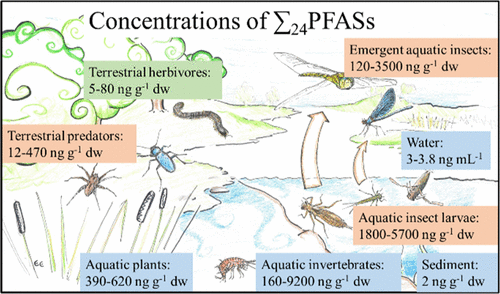当前位置:
X-MOL 学术
›
Environ. Sci. Technol.
›
论文详情
Our official English website, www.x-mol.net, welcomes your
feedback! (Note: you will need to create a separate account there.)
Per- and Polyfluoroalkyl-Contaminated Freshwater Impacts Adjacent Riparian Food Webs.
Environmental Science & Technology ( IF 10.8 ) Pub Date : 2020-09-01 , DOI: 10.1021/acs.est.0c01640 Alina Koch 1 , Micael Jonsson 2 , Leo W Y Yeung 1 , Anna Kärrman 1 , Lutz Ahrens 3 , Alf Ekblad 1 , Thanh Wang 1
Environmental Science & Technology ( IF 10.8 ) Pub Date : 2020-09-01 , DOI: 10.1021/acs.est.0c01640 Alina Koch 1 , Micael Jonsson 2 , Leo W Y Yeung 1 , Anna Kärrman 1 , Lutz Ahrens 3 , Alf Ekblad 1 , Thanh Wang 1
Affiliation

|
The occurrence of per- and polyfluoroalkyl substances (PFASs) in aquatic ecosystems is a global concern because of their persistence, potential bioaccumulation, and toxicity. In this study, we investigated a PFAS-contaminated pond in Sweden to assess the cross-boundary transfer of PFASs from the aquatic environment to the riparian zone via emergent aquatic insects. Aquatic and terrestrial invertebrates, surface water, sediments, soils, and plants were analyzed for 24 PFASs including branched isomers. Stable isotope analysis of carbon and nitrogen was performed to elucidate the importance of diet and trophic position for PFAS uptake. We present the first evidence that PFASs can propagate to the riparian food web via aquatic emergent insects. Elevated Σ24PFAS concentrations were found in aquatic insect larvae, such as dragon- and damselflies, ranging from 1100 to 4600 ng g–1 dry weight (dw), and remained high in emerged adults (120–3500 ng g–1 dw), indicating exposure risks for top predators that prey in riparian zones. In terrestrial invertebrate consumers, PFAS concentrations increased with the degree of aquatic-based diet and at higher trophic levels. Furthermore, stable isotope data together with calculated bioaccumulation factors indicated that bioconcentration of PFASs was the major pathway of exposure in the aquatic food web and bioaccumulation in the riparian food web.
中文翻译:

被全氟烷基和多氟烷基污染的淡水对河岸食物网的影响。
由于全氟烷基物质和全氟烷基物质的持久性,潜在的生物蓄积性和毒性,它们在水生生态系统中的发生是全球关注的问题。在这项研究中,我们调查了瑞典一个被PFAS污染的池塘,以评估PFAS通过新兴水生昆虫从水生环境到河岸带的跨界转移。分析了24种PFAS(包括分支异构体)的水生和陆生无脊椎动物,地表水,沉积物,土壤和植物。进行了碳和氮的稳定同位素分析,以阐明饮食和营养位置对PFAS摄取的重要性。我们提出的第一个证据表明,PFASs可以通过水生昆虫传播到河岸食物网。高架Σ 24在水生昆虫幼虫(如龙和豆娘)中发现PFAS的浓度范围为1100至4600 ng g –1干重(dw),而在成年成年人中仍然很高(120–3500 ng g –1 dw),表明暴露在河岸带捕食的顶级掠食者的风险。在陆生无脊椎动物消费者中,PFAS浓度随水生饮食的程度和营养水平的提高而增加。此外,稳定的同位素数据以及计算得出的生物富集因子表明,PFAS的生物富集是水生食物网中暴露和河岸食物网中生物富集的主要途径。
更新日期:2020-10-06
中文翻译:

被全氟烷基和多氟烷基污染的淡水对河岸食物网的影响。
由于全氟烷基物质和全氟烷基物质的持久性,潜在的生物蓄积性和毒性,它们在水生生态系统中的发生是全球关注的问题。在这项研究中,我们调查了瑞典一个被PFAS污染的池塘,以评估PFAS通过新兴水生昆虫从水生环境到河岸带的跨界转移。分析了24种PFAS(包括分支异构体)的水生和陆生无脊椎动物,地表水,沉积物,土壤和植物。进行了碳和氮的稳定同位素分析,以阐明饮食和营养位置对PFAS摄取的重要性。我们提出的第一个证据表明,PFASs可以通过水生昆虫传播到河岸食物网。高架Σ 24在水生昆虫幼虫(如龙和豆娘)中发现PFAS的浓度范围为1100至4600 ng g –1干重(dw),而在成年成年人中仍然很高(120–3500 ng g –1 dw),表明暴露在河岸带捕食的顶级掠食者的风险。在陆生无脊椎动物消费者中,PFAS浓度随水生饮食的程度和营养水平的提高而增加。此外,稳定的同位素数据以及计算得出的生物富集因子表明,PFAS的生物富集是水生食物网中暴露和河岸食物网中生物富集的主要途径。











































 京公网安备 11010802027423号
京公网安备 11010802027423号